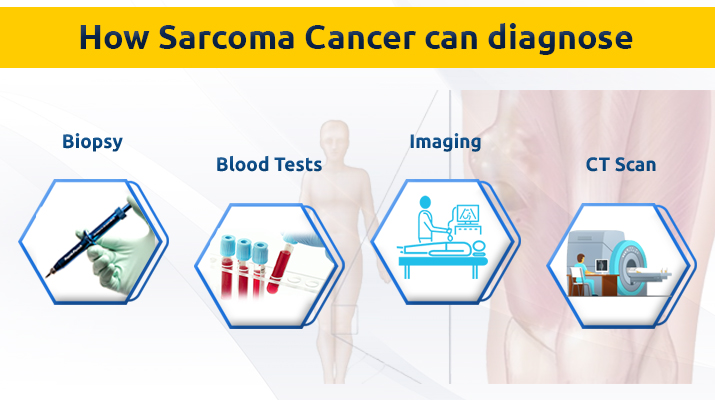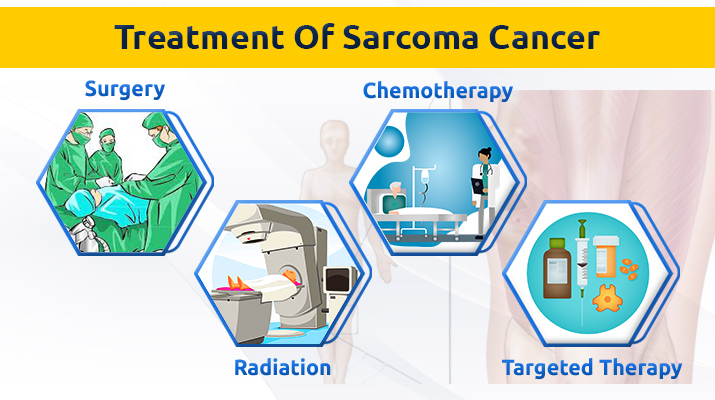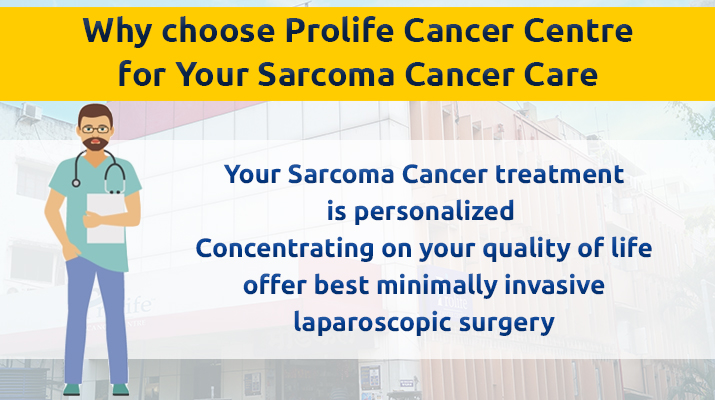What is Soft Tissue Sarcomas?
Soft tissue sarcomas are group of cancers that typically develop in the soft tissues surrounding, connecting or supporting the body’s structures and organs. These tissues includes muscles, joints, tendons, fat, blood vessels, nerves and tissues.
Some soft-tissue tumors, such as lipomas and hemangiomas, are benign (not cancer). Others are malignant (cancer) and are called soft tissue sarcomas. There are more than 30 types of sarcoma, making each extremely rare. Sarcomas are classified into groups that have similar types of cancer cells and symptoms. They usually are named for the type of tissue where they start. Sarcomas within a classification often are treated the same way.
Types of Sarcomas Cancer :
The main types of soft-tissue sarcoma begin in:
- Muscle tissue
- Peripheral nerve tissue
- Joint tissue
- Blood and lymph vessels
- Fibrous tissue
Sarcomas of uncertain tissue type: In this type of sarcoma, doctors are not able to determine the exact type of tissue where the cancer began.
What are the symptoms of soft tissue sarcoma?
Signs of sarcoma vary from person to person. Many times sarcoma does not have symptoms in the early stages. Only about half of soft-tissue sarcomas are found in the early stages before they spread.
The location of the sarcoma makes a difference in the symptoms. For instance if they start:
- On the arms or legs, you may notice a lump that grows over a period of weeks to months. It may hurt, but it usually doesn’t.
- In the retroperitoneum (the back wall inside the abdomen), they may cause problems that have symptoms, such as pain. Tumors may cause blockage or bleeding of the stomach or bowels. They may grow large enough for the tumor to be felt in the abdomen.
- A new lump or a lump that is growing anywhere on your body
- Abdominal pain that is getting worse
- Blood in your stool or vomit
- Black, tarry stools (this may mean there is internal bleeding).
These symptoms do not always mean you have sarcoma. However, it is important to discuss any symptoms with your doctor, since they may also signal other health problems. Some cases of soft tissue sarcoma can be passed down from one generation to the next. Genetic counseling may be right for you.
Sarcomas Cancer Types
Book Appointment
Quick Contact
- Address 557A1/15C Gultekadi, Market Yard Pune, Maharashtra 411037
- Email social.prolife@gmail.com
- Phone +91-9607079019, +91-9607079029
Soft Tissue Sarcoma Risk Factors
Anything that increases your chance of getting cancer is a risk factor. For sarcoma, risk factors include:
Inherited genetic conditions such as:
- Von Recklinghausen disease
- Li-Fraumeni syndrome
- Gardner syndrome
- Inherited retinoblastoma
- Werner syndrome
- Gorlin syndrome
- Tuberous sclerosis
- Damage or removal of lymph nodes during previous cancer treatments.
- Exposure to vinyl chloride, a chemical used in making plastics.
- Previous radiation treatment for another cancer.
Other risk factors include:
- Fine needle aspiration (FNA): A very small needle is placed into the tumor and suction is applied. CT (computed tomography) scans may be used to help guide the needle.
- Core needle: The doctor uses a needle slightly larger than the one used in an FNA biopsy to remove a cylindrical sample of tissue.
- Incisional: An incision (cut) is made in the skin and a small part of tumor is removed.
- Excisional: An incision (cut) is made in the skin and the entire growth is removed surgically.
How is soft tissue sarcoma diagnosed?

We have the latest methods and technology to be sure you get the most accurate diagnosis possible. This can make a difference in the success of your treatment.
Accurate Diagnosis is Essential
Since sarcomas are complex and can develop in so many places in the body, they can be difficult to diagnose. However, it’s important to have an accurate diagnosis of the type and extent of the sarcoma before you are treated.
If you have symptoms that may signal sarcoma, your doctor will examine you and ask you questions about your health and your family medical history.
Sarcoma Diagnostic Tests
The only way to be certain a tumor is sarcoma is a biopsy (removing a small number of cells to examine under a microscope). Imaging tests may be used before or after biopsy to determine the location and extent of the tumor.
Biopsy
The doctor will choose one of the following types of biopsy depending on where the tumor is.
- Fine needle aspiration (FNA): A very small needle is placed into the tumor and suction is applied. CT (computed tomography) scans may be used to help guide the needle.
- Core needle: The doctor uses a needle slightly larger than the one used in an FNA biopsy to remove a cylindrical sample of tissue.
- Incisional: An incision (cut) is made in the skin and a small part of tumor is removed.
- Excisional: An incision (cut) is made in the skin and the entire growth is removed surgically.
Stages of Srcomas
Stage 1A
T1, N0, M0, G1 or GX: The tumor is not larger than 5 cm (2 inches) across (T1). It has not spread to lymph nodes (N0) or more distant sites (M0). The cancer is grade 1 (or the grade cannot be assessed).
Stage 1B
T2, N0, M0, G1 or GX: The tumor is larger than 5 cm (2 inches) across (T2). It has not spread to lymph nodes (N0) or more distant sites (M0). The cancer is grade 1 (or the grade cannot be assessed).
Stage 2A
T1, N0, M0, G2 or G3: The tumor is not larger than 5 cm (2 inches) across (T1). It has not spread to lymph nodes (N0) or more distant sites (M0). The cancer is grade 2 or 3.
Stage 2B
T2, N0, M0, G2: The tumor is larger than 5 cm (2 inches) across (T2). It has not spread to lymph nodes (N0) or more distant sites (M0). The cancer is grade 2.
Stage 3: Either
T2, N0, M0, G3: It is larger than 5 cm (2 inches) across (T2). It has not spread to lymph nodes (N0) or more distant sites (M0). The cancer is grade 3, OR
Any T, N1, M0, any G: The cancer can be any size (any T) and any grade. It has spread to nearby lymph nodes (N1). It has not spread to distant sites (M0).
Stage 4
Any G, Any T, Any N, M1: The tumor has spread to lymph nodes near the tumor (N1) and/or to distant sites (M1). It can be any size (any T) and grade (any G).
Once the staging classification is determined, the stage stays the same even if treatment is successful or the cancer spreads.
What are the treatment options for soft tissue sarcoma?

Our surgeons are among the most skilled in the world in surgery for sarcoma. They use the latest techniques, including limb-sparing surgeries, which we helped pioneer. Usually patients are able to avoid the loss of an arm or leg.
Our Sarcoma Treatments
Sarcomas usually are treated with a combination of therapies that may include surgery, chemotherapy and radiation. If you are diagnosed with sarcoma, your doctor will discuss the best options to treat it. This depends on several factors, including:
- The location and type of sarcoma
- If the cancer has spread
- Possible impact on your body
- Your general health
Your treatment for sarcoma will be customized to your particular needs. It may include one or more of the following.
Surgery
Like all surgeries, sarcoma surgery is most successful when performed by a specialist with a great deal of experience in the particular procedure.
Surgery is the main treatment for soft-tissue sarcomas. The surgeon removes the tumor, as well as a margin of healthy tissue around it to take out as many cancer cells as possible. You may receive chemotherapy or radiation therapy before or after the surgery.
Chemotherapy
We offers the most up-to-date and advanced chemotherapy options. Chemotherapy may be used as the main treatment for sarcoma or with surgery or radiation. A combination of two or more chemotherapy drugs may be used.
Radiation Therapy
New radiation therapy techniques and remarkable skill allow doctors to target tumors more precisely, delivering the maximum amount of radiation with the least damage to healthy cells.
Radiation therapy usually is not used as the main treatment for sarcoma, but it may be used before surgery to shrink the tumor or after surgery to destroy remaining cancer cells.
Proton Therapy
The Proton Therapy Center is one of the largest and most advanced centers in the world. It’s the only proton therapy facility in the country located within a comprehensive cancer center.
Proton therapy delivers high radiation doses directly to the tumor site, sparing nearby healthy tissue and vital organs. For some patients, this therapy results in better cancer control with less impact on the body.
Prognosis & Followup

A prognosis is the Oncologist’s best estimate of how cancer will affect someone and how it will respond to treatment.
Prognosis and survival depend on many factors. Only a Oncologist familiar with your medical history, the type, stage and characteristics of your cancer, the treatments chosen and the response to treatment can put all of this information together with survival statistics to arrive at a prognosis.
A prognostic factor is an aspect of the cancer or a characteristic of the person that the oncologist will consider when making a prognosis.
A predictive factor influences how a cancer will respond to a certain treatment. Prognostic and predictive factors both play a part in deciding on a treatment plan and a prognosis.
Oncologist use different prognostic and predictive factors for newly diagnosed and recurrent breast cancers.
Why choose Prolife cancer centre for soft tissue sarcoma care?

Prolife features one of the few medical teams in the world devoted to soft-tissue sarcomas. Our experts customize your care to deliver the most successful treatment, while focusing on your quality of life.
We see more sarcoma patients in a day than many cancer centers do in a year. This gives us a level of expertise and experience that can make a difference in your outcome.
Diagnosis of sarcomas can be challenging, but accurate diagnosis is essential to successful treatment. In fact, having an inaccurate or unsuccessful biopsy can be harmful. Our pathologists are dedicated to sarcoma, and they use the latest, most-sophisticated tests to pinpoint the type and extent of the cancer.

